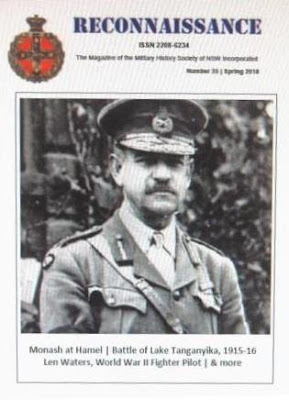Editor's Comment: Reconnaissance Spring 2018 edition
Editor's Comment from the Spring 2018 edition of Reconnaissance, the quarterly magazine of the Military History Society of New South Wales.
In
this edition we present just two feature articles as they are much longer than
usual. But I’m sure you will agree they are well worth presenting in full. Both
are papers delivered to a monthly meeting of the Society this year. And,
fittingly, both are about World War I.
2018
is the centenary year of some momentous battles which finally brought the Great
War to an end. A number of new books, symposiums and commemorative ceremonies
have drawn the public’s attention to the historical significance of those
engagements as well as the tenacity, skill and heroism of the participants. Our
Australian Army Corps, in particular, played a significant role in the last
push to victory. The final campaigns were always bound to attract a degree of
discussion and debate. But one battle fought on 4 July 1918 has captured an
outsized share of the attention.
Much of this was sparked by Peter FitzSimons’ book Monash’s Masterpiece: The Battle of Hamel and the 93 Minutes that Changed the World. As the title suggests, FitzSimons invests Hamel with unparalleled qualities. This view has been sharply challenged. For example, Aaron Pegram of the Australian War Memorial and Andrew Richardson of the Australian Army History Unit argue strongly that while the battle and Monash’s performance warrant high praise, the encounter had minimal impact on the course of World War I, let alone world history. In this edition of Reconnaissance, our Vice-President Robert Muscat enters the debate, arguing that though Monash’s leadership and tactics were innovative in some respects, the great man drew largely on existing British military doctrine as it had been developing since 1916.
Then
Dennis Weatherall tells the tale of a World War I campaign so colourful and
bizarre that anyone would be excused for thinking it was cooked up by a drunk
Hollywood scriptwriter. But it’s all true. How many people know that early in
the war, a disreputable British game hunter persuaded the Admiralty of the
Royal Navy to drag a pair of gunboats 2,300 miles overland from Capetown to
Lake Tanganyika and there attack naval vessels of Imperial Germany in order to
confiscate its East African territory? Read the cracking story for yourself.
Also
in this edition I review an inspiring book on the life of Len Waters, an
indigenous Australian born into the shanty town of Toomelah Aboriginal reserve
who defied all the odds to become a fighter pilot in the South West Pacific
theatre of World War II.
Finally,
we introduce a new feature to Reconnaissance
in the form of a Military History News Calendar recording important events in
the world of military history over the last quarter, like new books, articles,
issues of magazines, movies, television programs, awards, honours,
anniversaries, centenaries, commemorations, new memorials, deaths of notable
people and so on. I hope you find this useful and interesting.
Editor, Reconnaissance
Reconnaissance is available to members of the Society. Why not join? Visit the membership page of our website here: http://militaryhistorynsw.com.au/home/membership/

.png)
.png)

Comments
Post a Comment